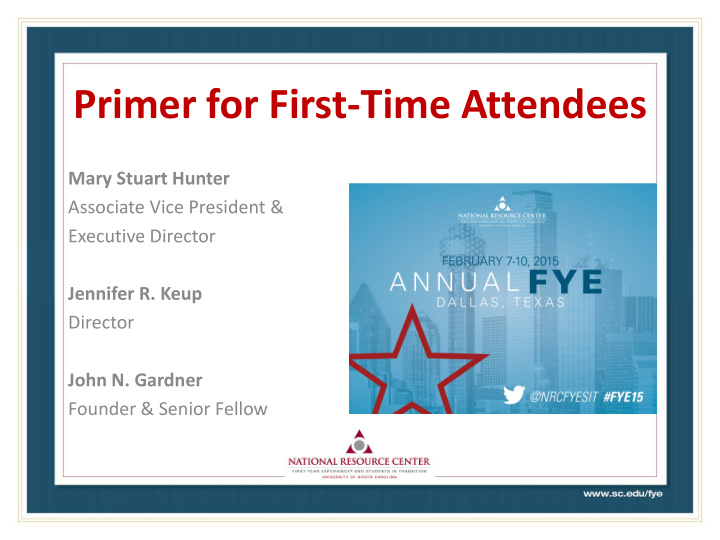



Primer for First-Time Attendees Mary Stuart Hunter Associate Vice President & Executive Director Jennifer R. Keup Director John N. Gardner Founder & Senior Fellow
Definitions of Primer • Primer – any book of elementary principles • Primer – a person or thing that primes; a first coat of paint, size, etc, given to any surface as a base, sealer, or the like
Primer Goals • historical and cultural context for the first-year experience movement • developmental mileposts of the Center • current campus trends of interest • future of the first year of college and the challenges ahead for educators • strategies for making the most of the conference • getting involved with the work of the Center
Foundations and Beginnings of FYE • Student activism and a riot at the University of South Carolina • Spring 1970 • President Thomas F. Jones • Social justice
• 1982 – National conference on the freshman seminar / freshman orientation course concept • 1983 – Annual conference on the Freshman Year Experience begins • 1986 – The Center is chartered, established the following year; first International Conference on the First-Year Experience held in the UK
• 1988 – First monograph published; First newsletter published; First national research study • 1989 – Journal introduced • 1990 – First national recognition process established (Outstanding First-Year Advocates) • 1994 – Website launched; First listserv created
• 1999 – John Gardner retires, Stuart Hunter becomes director • 2003 – E-source for College Transitions e lectronic newsletter launched • 2005 – Paul P. Fidler Research Grant established • 2007 – Stuart Hunter promoted, national search identifies Jennifer Keup as 3 rd director
• 2008 – First Institute for First-Year Seminar Leadership held, other institutes followed; the Center received ASHE special merit award • 2010 – Online courses offered for the first time; national award established to recognize Excellence in Teaching First-Year Seminars
• 2012-2013 - Release of a 5- volume series on First-Year Seminars • 2013 - 25 th anniversary issue of the Journal on the First-Year Experience and Students in Transition published; 2 nd administration of the National Survey of Peer Leaders • 2015 – 24 th Annual Conference on the First-Year Experience!
Current Campus Trends of Interest • Reaching out to students before they begin their studies • Recognition of the importance on induction and orientation periods
• Peer support and peer education • Attending to student success in gateway courses • Student-centered teaching • Continuing support beyond the first year
• Partnerships and collaboration • Campus attention to families of undergraduates • Response to greater mental and emotional health needs of today’s students
• Technology and distance education • Emphasis on employability and career pathways • External influences on FYE • Economic realities and financial influences • Questioning of ROI and levels of student debt
• Increasing demand for assessment and data-driven decisions • Pioneering use of predictive analytics
• Moving beyond program focus to comprehensive approaches • Reinvisioning our models to work with the new demographics in our institutions • New goals of helping students thrive
The Future: Meeting Needs, Setting Agendas • Evolution of FYE as a field of study • Moving beyond retention • Advocacy • Internationalization of FYE • FYE and high-impact practices
• Advancing research and scholarship on student transition and success • Engaging new voices; fostering the next generation of leaders • Recognizing excellence
Making the Most of the Conference • Be sure to read the opening pages of the program book • Note different types of sessions • Attend sessions on a wide variety of topics
• Make effort to network and meet new colleagues • Visit the exhibit booths • Excess handout table at the conference; website presentation center later • Participate in evaluation opportunities
Getting Involved: Step #1 • Join the FYE-listserv and/or FYA-listserv Free!! • “Like” the National Resource Center on Facebook • Subscribe to The ToolBox and/or E-Source for College Transitions newsletters • Follow the National Resource Center on Twitter • Enter your program into the interactive databases of the Center’s website • Submit an article to E-Source • Nominate a colleague for a Center-sponsored recognition program
Getting Involved: Step #2 • Purchase a publication in your functional area • Subscribe to the Journal of The First-Year Experience and Students in Transition • Attend an upcoming conference or institute • Plan to attend a preconference workshop • Participate in the Center’s conference mentoring program • Enroll in an online course
Getting Involved: Step #3 • Propose/present a session or preconference workshop for a future conference • Review session proposals for conferences • Submit a scholarly article to the Journal • Submit a scholarly-practice book proposal • Submit a proposal for the Paul P. Fidler Research Grant competition • SPECIAL CONSIDERATIONS: – Institutional co-host for a conference – Review Board for the Journal
Welcome to the 34 rd Annual Conference on the FYE ! Mary Stuart Hunter shunter@sc.edu Jennifer R. Keup keupj@mailbox.sc.edu John N. Gardner gardner@jngi.org
Recommend
More recommend